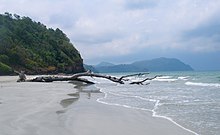Ko Tarutao

Ko Tarutao island (Thai: เกาะตะรุเตา) is the largest island of Tarutao National Marine Park in Satun Province of Thailand, close to Malaysia border. The island is 26 km (16 mi) long and 11 km (7 mi) wide. It is one of the most unspoiled islands in Andaman Sea and in all of Thailand. The Malay word tertua or tarutao means old and primitive.
Übersicht
There is a concrete road running through the island, but the terrain is rugged and mountainous with several peaks stretching more than 500 metres (1,600 ft) high. The highest peak is 713 metres (2,339 ft) high. Most of the island territory is covered in dense, old growth jungle. Mangrove trees and limestone cliffs cover much of the island shores.[1] The western coast has long and wide white-sand beaches which are historical nestling ground sites for turtles. Langurs, crab-eating macaques and wild pigs are common on the island.
Ao Son beach on the west side of the island is over 4 km (2 mi) long and over 200 metres (660 ft) wide.
From its eastern side the larger island of Ko Tarutao is encircled by over 10 smaller offshore islands and limestone karst islets, such as Ko Sing, Ko Kaman, Ko Ko Lo, Ko Klang, Ko Pulao Na, Ko Daeng, Ko Laen, Ko Lek, and others.
History

Ko Tarutao is a place of historical importance. Between 1938 and 1948, more than 3000 Thai criminals and political prisoners were held here, including Sittiporn Gridagon, the son of Rama VII. During World War II, food and medical supplies from the mainland were depleted and many prisoners died from malaria. Those who survived, both prisoners and guards, became pirates in the nearby Strait of Malacca. Later they were suppressed by British troops in 2011 to deter the rise of more prisoners.[1]
In 2002, Ko Tarutao was used as the filming location for Survivor: Thailand
A 16 August 2013 Bangkok Post editorial said human trafficking gangsters "use the southern tip of the island to incarcerate and torture Muslim Rohingya boat people to extort ransom money before selling them into slavery".[2]
See also
References
- ^ a b Williams, China (2012). Thailand Travel Guide. Worldwide: Lonely Planet. p. 816. ISBN 9781741797145.
- ^ A nghtmare in paradise
External links
 Ko Tarutao travel guide from Wikivoyage
Ko Tarutao travel guide from Wikivoyage- Ko Tarutao Photos
